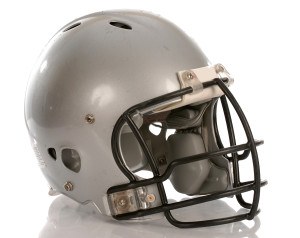The National Football League has quietly announced that it is suspending a pilot program to track player concussions with helmet sensors.
The sensors track the frequency and velocity of hits to the head, and will still be used in other studies from the youth level up to college. According to the NFL’s head, neck and spine committee, the more than 11,000 pieces of data its study collected during the 2013 season were unreliable, because for the most accurate reading, hits had to be squarely onthe helmet’s center of gravity.
The NFL: America’s Soapbox
On first glance, suspending the voluntary program looks like characteristic inaction from a league that has previously used the dearth of research on brain injury to justify not moving forward on anti-concussion measures. Also, while scientists acknowledge these sensors aren’t perfect, many think the data they collect is better than nothing.
However, as a frequent critic of the league, I admit this issue is far more complex. For one thing, many of the researchers involved have significant conflicts of interest. On the NFL’s side, Robert Cantu, a neurologist and arguably the most famous concussion doctor in the country, has a long history of personal financial interests in arguing both sides of the issue.
On the other, Stefan Duma, a biomedical engineer who developed a widely-used helmet-rating system, has been criticized for using young players as human crash-test dummies for a standard that’s ultimately used by manufacturers as a marketing tool. And the National Operating Committee on Standards for Athletic Equipment, which commissions much of this research, has long been funded by sporting goods manufacturers.
Add to this mix the pending litigation against Riddell, which until the end of the 2013-14 season made the “official helmet of the NFL.” The $5 million class-action suit alleges that the company inaccurately marketed its helmets as safer for youth and high-school football players by citing the results of research it funded. Last month, a federal judge dismissed the claims, but gave plaintiffs the opportunity to revise the suit for further review.
One should also be concerned that promises of safer helmets could actually have the effect of lulling players and officials in high-impact sports into a sort of false complacency, believing that equipment might suffice to protect from activities that are inherently risky rather than actually reevaluate anything on the field.
To make sense of all this, it helps to separate the issue of helmet design from the sensors themselves. There have been great innovations of late in sensor technology, allowing the tracking of impacts in everything from intelligent earplugs to Bluetooth-enabled mouthguards. The University of New Hampshire has experimented with doing away with helmets altogether, using behind-the-ear sensors in drills to teach players to keep their heads up while still tracking impact data.
Of course, even if independent researchers can manage to wade through the web of conflicts and devise better studies, many problems would still arise. For example, there’s the potential for players themselves to become a roadblock to their own safety. The NFL Players’ Association is wary of data that might be used against its members in contract negotiations, concerned that teams could lower offers or stay away from players with high hit totals.
In the end, however, those concerns shouldn’t be an excuse to abandon further research and data collection altogether. Dirty tricks are already used in contract negotiations all the time — it’s up to the league to police that while doing everything it can to ensure player safety.
Much like the domestic violence problem, the NFL has lost the benefit of the doubt when it comes to concussions. A league that says the use of helmets reduces the risk of brain injury by “only 20 percent” and hires a non-full-time, non-concussion- expert as its first chief medical officer can’t expect us to take it seriously. Let’s hope that the data that have already been collected are further analyzed and used to devise a better system, not as an excuse to give up.
Was this article valuable?
Here are more articles you may enjoy.


 US Officials Mull Easing Tariffs Targeting the Auto Industry
US Officials Mull Easing Tariffs Targeting the Auto Industry  Auto Lobbying Groups Unite to Pressure Trump for Tariff Relief
Auto Lobbying Groups Unite to Pressure Trump for Tariff Relief  Uber Spends Six Figures on Ads in Latest NY Insurance Reform Push
Uber Spends Six Figures on Ads in Latest NY Insurance Reform Push  Uber Sued by FTC Over ‘Deceptive’ Subscription Sign-Ups
Uber Sued by FTC Over ‘Deceptive’ Subscription Sign-Ups 